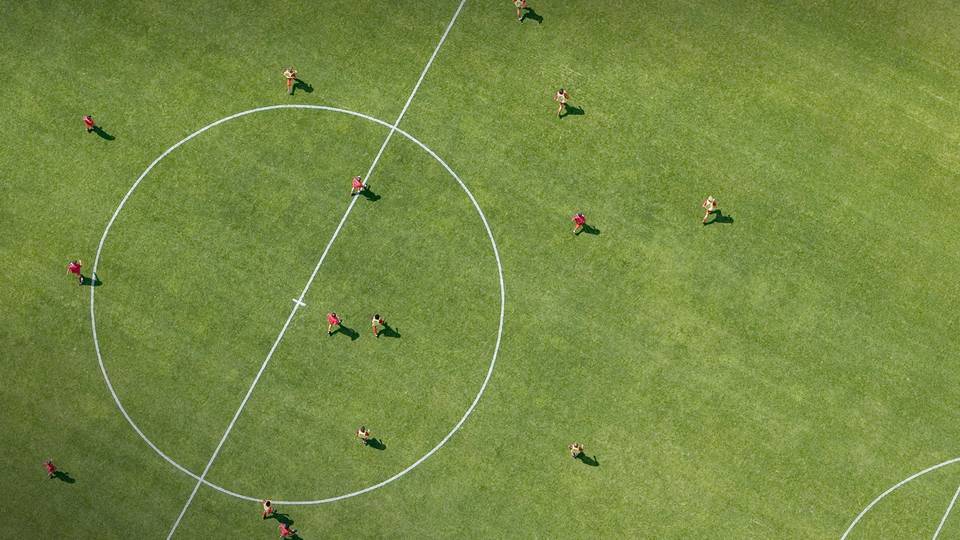In the fast-paced world of 7-a-side football, tactics can make or break your team's performance. Whether you're coaching adults or children, understanding the right formations and strategies is crucial for success on the smaller pitch. Choosing the optimal formation for your 7-a-side team depends on your players' strengths, with popular options including 2-3-1, 3-2-1, and 3-1-2 arrangements that balance defensive solidity with attacking threat.
The 7v7 format presents unique tactical challenges compared to the traditional 11-a-side game. With less space but similar principles, teams must adapt their approach - focusing on quick transitions, positional awareness and simplified attacking patterns. The reduced player count means each team member has more responsibility and touches of the ball, making individual technical ability and decision-making even more important.
Many amateur coaches across the UK overlook the tactical nuances of the shorter-sided game, treating it as merely a smaller version of traditional football. However, successful 7-a-side teams develop specific strategies that exploit the different dimensions and dynamics. Effective tactics include creating overloads in key areas, maintaining proper spacing, and ensuring goalkeepers are comfortable with both short distribution and longer options to vary the point of attack.
Understanding 7-A-Side Football
Seven-a-side football represents a dynamic, fast-paced version of the beautiful game that requires specific tactical awareness and positional understanding. The reduced player count creates unique challenges and opportunities that differ significantly from the 11-a-side format.
Key Rules and Pitch Dimensions
7-a-side matches are typically played on smaller pitches, usually between 50-60 metres in length and 30-40 metres in width. This compressed playing area demands quicker decision-making and sharper technical skills.
The penalty area is generally smaller than in the standard game, extending approximately 9 metres from the goal line. Most competitions enforce a "retreat line" rule where defenders must retreat to the halfway line for goal kicks, encouraging teams to build from the back.
Match duration is usually shorter, with games lasting between 40-60 minutes, split into two halves. The offside rule is often eliminated in 7v7 formats, which significantly changes attacking dynamics and defensive positioning.
Rolling substitutions are typically permitted, allowing teams to maintain high-intensity throughout matches and make tactical adjustments more frequently.
Positional Roles and Responsibilities
Goalkeeper: Beyond shot-stopping, the goalkeeper in 7-a-side must be comfortable with the ball at their feet and capable of functioning as an additional outfield player when needed.
Defenders: Centre-backs require excellent reading of the game and positioning skills. They must be comfortable in 1v1 situations and possess good distribution abilities.
Midfielders: The engine of the team, midfielders in 7-a-side need exceptional stamina and technical ability. Central midfielders typically balance defensive cover with attacking support.
Attackers: Forwards must be clinical finishers but also contribute defensively. With no offside rule in many formats, intelligent movement and timing become crucial for creating scoring opportunities.
Every player must be versatile, as rigid positional play is less effective in the fluid nature of 7-a-side football.
The Importance of Team Formations
The most common 7-a-side formations include:
- 2-3-1: Balanced approach with two defenders, three midfielders, and one striker
- 3-2-1: Defensively solid setup with three at the back
- 2-1-3: Attack-minded formation suitable for teams with strong technical ability
- 1-3-2: Flexible formation that relies on a strong single defender
- 3-1-2: Provides good defensive cover while maintaining attacking options
Formation choice should reflect team strengths and playing philosophy. The reduced space makes transitions between attack and defence rapid, requiring formations that can adapt quickly.
Effective formations maintain proper width while ensuring defensive solidity. Unlike in 11-a-side soccer, players must be comfortable rotating positions as play develops, making tactical discipline and spatial awareness essential skills.
Key Team Tactics and Setups
Effective tactics in 7-a-side football rely on structured formations and clear player roles to maximise limited space and personnel. While traditional 3-2-1 and 2-3-1 formations remain popular in the 7v7 format, other tactical approaches can be adapted from the 11-a-side game.
The 4-2-3-1 Formation Explained
The 4-2-3-1 formation can be effectively modified for 7-a-side as a 2-1-3-1 setup. This arrangement provides excellent defensive stability while enabling attacking options.
In this system, two defenders form a solid backline, protecting the goal and initiating build-up play. One holding midfielder sits in front, serving as the tactical pivot.
The three attacking midfielders operate in a compact line, with wider players supporting both offensive movements and defensive responsibilities. This trio creates triangular passing options, vital in tight spaces.
The lone striker focuses on movement in the final third, creating space and finishing chances. This formation works best when players understand positional fluidity.
Key advantages:
- Balanced defensive coverage
- Multiple passing lanes
- Clear positional responsibilities
- Adaptability against various opponents
Implementing High Press Strategies
High pressing in 7-a-side football requires coordinated team effort and excellent fitness levels. The objective is to win the ball in advanced positions, catching opponents off guard.
Players must press as a cohesive unit, maintaining appropriate distances between each other. The trigger for pressing could be a poor touch, a backward pass, or when opponents reach certain zones.
Effective pressing principles:
- Press in threes (primary presser plus two supporting players)
- Cut passing lanes rather than rushing directly at the ball
- Communicate constantly to maintain the pressing structure
- Recover position quickly if the press is broken
Central midfielders are crucial in a high press system. They must read the game intelligently, stepping forward to press or dropping back to cover spaces left by pressing teammates.
Rest periods during possession phases help maintain energy for pressing actions. Without strategic rest, teams risk becoming vulnerable to counter-attacks as fatigue sets in.
Defensive Approaches: The Low Block
A low block defensive strategy can be particularly effective in 7-a-side football, especially against technically superior opponents. This approach prioritises defensive solidity over possession.
The team sets up in a compact formation, typically withdrawing to their own half when out of possession. Players maintain minimal distance between defensive lines, usually no more than 5-7 metres.
Key components of an effective low block:
- Disciplined positioning
- Patient defending (no rushing into tackles)
- Quick transitions when possession is regained
- Well-organised defensive shifting
The defensive line must maintain appropriate depth, avoiding positioning too close to their own goal. This prevents opponents from finding space behind while allowing defenders to intercept through balls.
Counter-attacking becomes the primary offensive outlet. When the ball is won, players must transition quickly with direct forward passes to exploit spaces left by the opponent's attacking structure.
Tactical Innovation and Adaptation
Successful 7-a-side teams constantly evolve their tactical approaches to stay competitive and overcome opponents. Innovation on the pitch comes from studying elite teams, adapting professional tactics to the smaller format, and developing flexibility to respond to changing game situations.
Learning from Barcelona's Tactical Success
Barcelona's tiki-taka philosophy translates beautifully to 7-a-side football, emphasizing possession and positional awareness. Their approach relies on quick, short passing triangles that create numerical advantages in tight spaces.
For 7v7 teams, adopting Barcelona's principles means prioritising technical players who can maintain possession under pressure. This requires regular training focused on one-touch passing drills and movement patterns.
The key Barcelona concept to implement is the creation of passing lanes. Players should position themselves at optimal distances—not too close to teammates (which invites pressing) and not too far (which makes accurate passing difficult).
Barcelona's defensive transition also offers valuable lessons. When possession is lost, immediate counter-pressing prevents opponents from launching attacks, particularly effective on smaller pitches where recovery distances are shorter.
Sir Alex Ferguson's Tactical Flexibility
Sir Alex Ferguson's greatest strength was his willingness to adapt tactics based on opposition analysis. His Manchester United teams could seamlessly switch between formations, even mid-match.
For 7-a-side coaches, Ferguson's approach teaches the value of tactical versatility. Training players to understand multiple positions creates a more adaptable squad.
Ferguson often employed counter-attacking football against stronger teams—a tactic perfectly suited to 7-a-side where transitions happen rapidly. This involves surrendering some possession while maintaining defensive shape, then exploiting spaces when winning the ball.
His emphasis on wide play can be modified for the smaller pitch by using overlapping runs from the wingbacks. This creates overloads in attacking areas, destabilising defensive structures.
Adapting to Game Situations
Successful 7-a-side teams master in-game tactical changes based on match circumstances. Recognising when to press high, when to sit deep, and when to counter-attack is essential.
Game management becomes crucial when leading or trailing. Teams ahead might adopt a more conservative approach, maintaining possession to control tempo and preserve energy.
Weather and pitch conditions significantly impact tactical choices in grassroots soccer. On wet surfaces, a more direct approach might prove more effective than intricate passing combinations.
Substitution timing and player rotation strategy deserve particular attention in 7-a-side. Fresh legs can dramatically change a match's dynamics, especially in tournaments where fatigue accumulates.
Reading opponents' tactical patterns during the first few minutes provides valuable insights. Teams should practice alternative approaches during training sessions to seamlessly transition between styles when required.












